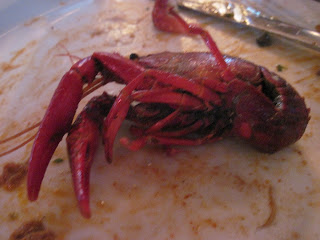On the east side of San Antonio is a great Creole restaurant, Ma Harper's. And on the west side of this city is a great Cajun restaurant, Acadiana. Both are off of I-410. I'll do a separate post on each restaurant at a later date. But this time the post will show one main difference between Creole and Cajun cooking.
The Tomato:
And that primary difference between Creole and Cajun dishes, in my Louisiana-raised opinion, is the tomato. Here is a photo of Ma Harper's Creole gumbo. You can see the red from the tomato in the dish. Creole food culture was centered around the New Orleans area, but has branched out over the years. Much of the influence came from the Africans who were migrated from the Caribbean Islands and brought the tomato with them. Tomatoes abound in warm climates.
Here is a photo of Acadiana's crawfish ettoufee stuffed into a pistolette. There is no tomato in this dish. The French Cajuns migrated from Nova Scotia Canada when the English took over after the French and Indian War. The Cajuns eventually settled in southwest Louisiana. Note: Tomatoes didn't grow in the cold climate of Canada during the 1700s.
Here is Ma Harper's jambalaya. Jambalaya has been traced back to the Caribbean. Jamba was derived from the Spanish word for ham.
Both the Creoles and Cajuns have parallel stewed dishes with slight differences (mainly the tomato): red beans and rice, jambalaya, gumbo, and ettoufee. Some stewed dishes are uniquely Creole such as Shrimp Creole because tomato is the main ingredient.
A Caribbean dish called fricassee stews meats and seafood in a tomato sauce. A Cajun fricassee is made without tomato. On the other hand, my Cajun-heritaged mom browned floured meats in hot oil. Water is added later for stewing. She always made the dish when my Creole-heritaged father was out of town.
A more sophisticated description of the difference between Creole and Cajun cooking can be found in Chef John Folse's cookbook, The Evolution of Cajun & Creole Cuisine.
Boiled Crawfish:
Cajuns and Creoles virtually boil crawfish the same. Most Texans I know don't. Many Texas restaurants that I have visited boil crawfish in salted water and throw the seasoning on at the end. Lips burn, but not the pallet.
In Louisiana, crawfish is boiled in seasoned water for a short time (3 minutes after the water returns to a boil) and then soaked for 30 minutes in the seasoned broth. Ice added to the pot helps send the seasoning back into the heads.
If you have guests who cannot handle spicy food, take their portion out as soon as the boiling is over. Do not allow their part to soak and do not add the ice until their's is removed.
The crawfish photo above came from Acadiana who knows how to boil crawfish the Louisiana way. Good stuff.
After your crawfish boil, pour the hot broth on pesky red ant nests. Take the left over crawfish heads and boil them to make a stock. Strain the stock and then reduce it to 50%. Freeze the reduction in an old fashion ice cube tray. When frozen, dump the cubes in a plastic bag to use later when making a gumbo or stewing seafood.
For more information about Acadiana, go to www.acadianacafe.com.



